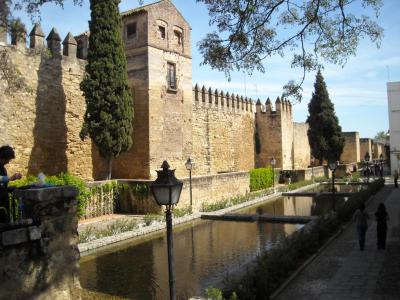Murallas Romana de Cordoba (Roman Walls of Cordoba), Cordoba
The Roman Walls (Murallas Romana de Córdoba) surrounded Cordoba. They were almost 9,000 feet in length and made of cut stone. There was an outer wall nine feet high and a four-foot inner wall. A 20-foot gap between the outer and inner walls was filled with rubble. There were semicircular defensive towers along the external wall.
The southern wall was demolished during the reign of Augustus to extend the city limits to the river Guadalquivir. The ruins of the Roman Walls remain in the Alcazar, by the Roman Bridge and the Roman Temple. The arches next to the Sevilla Gate (Puerta de Sevilla) are part of the Roman aqueduct.
In 711 AD, seven hundred Moorish soldiers led by a Berber commander Tariq Ibn Ziyad scaled the walls at night and drove out the startled Visigoths. Since the Islamic settlements were generally without defensive walls, the Roman structure gradually crumbled. In 1236 King Fernando of Castile conquered the city after a long siege.
In the 14th century, the walls were extended parallel to the river from the Albolafia water mill north and back again, reconnecting with the old walls at the Seville Gate (Puerta de Seville). Napoleon demolished parts of the wall. Today the remaining gates are the Almodovar Gate, Seville Gate, Bridge Gate, and the 1408 Malmuerta Tower.
The Roman Walls now form part of the historic center of Córdoba, a UNESCO World Heritage site, since 1984.
The southern wall was demolished during the reign of Augustus to extend the city limits to the river Guadalquivir. The ruins of the Roman Walls remain in the Alcazar, by the Roman Bridge and the Roman Temple. The arches next to the Sevilla Gate (Puerta de Sevilla) are part of the Roman aqueduct.
In 711 AD, seven hundred Moorish soldiers led by a Berber commander Tariq Ibn Ziyad scaled the walls at night and drove out the startled Visigoths. Since the Islamic settlements were generally without defensive walls, the Roman structure gradually crumbled. In 1236 King Fernando of Castile conquered the city after a long siege.
In the 14th century, the walls were extended parallel to the river from the Albolafia water mill north and back again, reconnecting with the old walls at the Seville Gate (Puerta de Seville). Napoleon demolished parts of the wall. Today the remaining gates are the Almodovar Gate, Seville Gate, Bridge Gate, and the 1408 Malmuerta Tower.
The Roman Walls now form part of the historic center of Córdoba, a UNESCO World Heritage site, since 1984.
Want to visit this sight? Check out these Self-Guided Walking Tours in Cordoba. Alternatively, you can download the mobile app "GPSmyCity: Walks in 1K+ Cities" from Apple App Store or Google Play Store. The app turns your mobile device to a personal tour guide and it works offline, so no data plan is needed when traveling abroad.
Murallas Romana de Cordoba (Roman Walls of Cordoba) on Map
Sight Name: Murallas Romana de Cordoba (Roman Walls of Cordoba)
Sight Location: Cordoba, Spain (See walking tours in Cordoba)
Sight Type: Attraction/Landmark
Guide(s) Containing This Sight:
Sight Location: Cordoba, Spain (See walking tours in Cordoba)
Sight Type: Attraction/Landmark
Guide(s) Containing This Sight:
Walking Tours in Cordoba, Spain
Create Your Own Walk in Cordoba
Creating your own self-guided walk in Cordoba is easy and fun. Choose the city attractions that you want to see and a walk route map will be created just for you. You can even set your hotel as the start point of the walk.
Ancient Roman Sites Walking Tour
Under all in Cordoba lies a once redoubtable Roman strongpoint. After Scipio's defeat of the Carthaginians in Llipa, the victorious Romans set up camp by the Guadalquivir River.
Under Augustus, the city gained the status of Colonia Patricia. A perimeter wall was built touching the Guadalquivir River. There were two forums, colonial and provincial. A large amphitheater has been uncovered.... view more
Tour Duration: 1 Hour(s)
Travel Distance: 2.5 Km or 1.6 Miles
Under Augustus, the city gained the status of Colonia Patricia. A perimeter wall was built touching the Guadalquivir River. There were two forums, colonial and provincial. A large amphitheater has been uncovered.... view more
Tour Duration: 1 Hour(s)
Travel Distance: 2.5 Km or 1.6 Miles
Cordoba Jewish Quarter Walk
Córdoba’s Jewish Quarter is one of the most atmospheric and historically rich districts of the city, located within the UNESCO-listed historic center. Its origins trace back to the Roman period, but it flourished most prominently during the Middle Ages, when Córdoba stood as one of the most important intellectual and cultural centers in Europe.
Under Muslim rule from the 8th to the 13th... view more
Tour Duration: 1 Hour(s)
Travel Distance: 0.4 Km or 0.2 Miles
Under Muslim rule from the 8th to the 13th... view more
Tour Duration: 1 Hour(s)
Travel Distance: 0.4 Km or 0.2 Miles
Cordoba Introduction Walking Tour
Córdoba treats history like a sculptor treats marble-layered, chiseled, and ever revealing something new. Situated in Andalusia, this city has seen empires rise, and its story spans over 2,200 years. Originally named Qart Juba by the Carthaginians, it was refounded in 206 BC by the Romans as Corduba. As the capital of the province Hispania Ulterior, it had to prove its reputation by having its... view more
Tour Duration: 2 Hour(s)
Travel Distance: 3.3 Km or 2.1 Miles
Tour Duration: 2 Hour(s)
Travel Distance: 3.3 Km or 2.1 Miles






